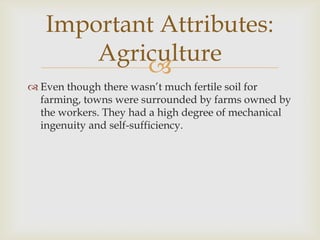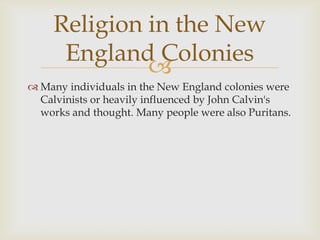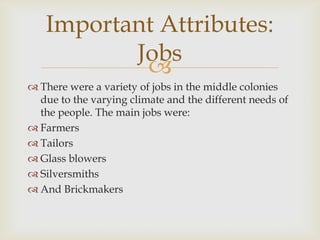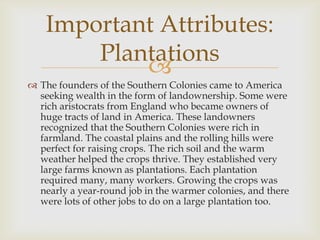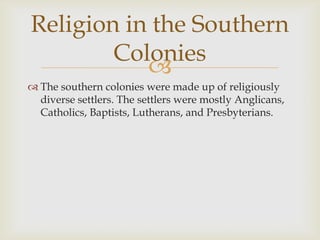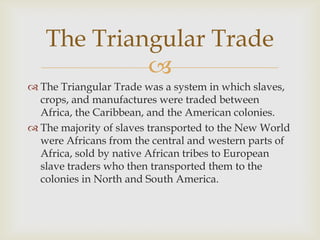Module 3 lesson 1 mastery assignment
- 2. The Original Colonies There are three groups used to categorize the original thirteen colonies. They are: The Southern colonies The New England colonies The Middle colonies
- 3. New England Colonies The four original New England colonies included: Massachusetts Rhode Island Connecticut New Hampshire
- 4. Important Attributes: Fishing New England colonies had rocky thin soil, so they couldn’t farm. Fishing brought great prosperity to the New England colonies. Whaling also brought in a lot of the colonies’ profits.
- 5. Important Attributes: Commerce The New England colonies were heavily involved in commerce. The trade with England allowed ship holders to flourish. Further, they traded with the West Indies and the French colonies to the north.
- 6. Important Attributes: Agriculture Even though there wasn’t much fertile soil for farming, towns were surrounded by farms owned by the workers. They had a high degree of mechanical ingenuity and self-sufficiency.
- 7. Religion in the New England Colonies Many individuals in the New England colonies were Calvinists or heavily influenced by John Calvin's works and thought. Many people were also Puritans.
- 8. Middle Colonies The original Middle Colonies were: Pennsylvania New York New Jersey Delaware
- 9. Important Attributes: Agriculture The middle colonies had fertile land. Land was generally acquired more easily than in New England or in the South. Wheat and corn from local farms would feed the American colonies through their colonial infancy and revolutionary adolescence.
- 10. Important Attributes: The “Breadbasket Colonies” The Middle colonies were not as well known for their farming as they were for their mills and bread. Their mills were powered by water. On average, a person in the Middle colonies ate about 1 pound of bread per day.
- 11. Important Attributes: Jobs There were a variety of jobs in the middle colonies due to the varying climate and the different needs of the people. The main jobs were: Farmers Tailors Glass blowers Silversmiths And Brickmakers
- 12. Religion in the Middle Colonies The Middle colonies presented an assortment of religions. The presence of Quakers, Mennonites, Lutherans, Dutch Calvinists, and Presbyterians made the dominance of one faith next to impossible.
- 13. Southern Colonies The original Southern colonies were: Maryland Virginia North Carolina South Carolina Georgia
- 14. Important Attributes: Plantations The founders of the Southern Colonies came to America seeking wealth in the form of landownership. Some were rich aristocrats from England who became owners of huge tracts of land in America. These landowners recognized that the Southern Colonies were rich in farmland. The coastal plains and the rolling hills were perfect for raising crops. The rich soil and the warm weather helped the crops thrive. They established very large farms known as plantations. Each plantation required many, many workers. Growing the crops was nearly a year-round job in the warmer colonies, and there were lots of other jobs to do on a large plantation too.
- 15. Important Attributes: Slaves Plantation owners could not find enough workers among the European immigrants to the United States. Most of these immigrants wanted to farm their own land, not work for someone else. The Native Americans were not interested in taking jobs on the plantations either. The plantation owners found the solution to their labor shortage on a Dutch slave ship. They purchased their first slaves in Jamestown in 1619. According to some histories, these first African Americans were known as servants rather than slaves. Either way, they were forced to work on the plantations.
- 16. Important Attributes: Agriculture The economy in the Southern colonies was dependent on farming. This is why plantations were so common in the south. The main types of crops produced were: Sugar Cotton Tobacco Coffee And Rice
- 17. Religion in the Southern Colonies The southern colonies were made up of religiously diverse settlers. The settlers were mostly Anglicans, Catholics, Baptists, Lutherans, and Presbyterians.
- 18. The Triangular Trade The Triangular Trade was a system in which slaves, crops, and manufactures were traded between Africa, the Caribbean, and the American colonies. The majority of slaves transported to the New World were Africans from the central and western parts of Africa, sold by native African tribes to European slave traders who then transported them to the colonies in North and South America.
- 19. The Great Awakening The Great Awakening was a spiritual renewal that swept the American Colonies, particularly New England, during the first half of the 18th Century. Certain Christians began to disassociate themselves with the established approach to worship at the time which had led to a general sense of complacency among believers, and instead they adopted an approach which was characterized by great fervor and emotion in prayer.
- 20. The Age of Enlightenment The Enlightenment was appreciated by many people in the colonies who tried to keep up with the advancements of the Europeans. Professor John Winthrop was among those responsible for the spread of enlightenment in America.





